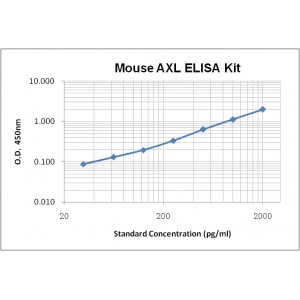More info
Assay Range | 31.2-2,000 pg/mL |
Sensitivity | 10.0 pg/mL |
Specificity | No cross-reaction with other related substances detected |
Size | 96T |
Storage | Store at 2 - 8ºC. Keep reconstituted standard and detection Ab at -20 ºC |
Assay Principle | Sandwich ELISA |
Sample Volume | 100 µL final volume, dilution factor varies on samples |
Detection Method | Chromogenic |
Kit Components
1. Recombinant Mouse Axl standard: 2 vials
2. One 96-well plate coated with Mouse Axl Ab
3. Sample diluent buffer: 12 mL - 1
4. Detection antibody: 130 µL, dilution 1:100
5. Streptavidin-HRP: 130 µL, dilution 1:100
6. Antibody diluent buffer: 12 mL x1
7. Streptavidin-HRP diluent buffer: 12 mL x1
8. TMB developing agent: 10 mL x1
9. Stop solution: 10 mL x1
10. Washing solution (20x): 25 mL x1
Background
Axl, also known as Ufo and Ark, is a large glycoprotein belonging to the TAM receptor tyrosine kinase family which includes Axl, Dtk/Tyro3, and Mer. The mouse Axl is synthesized as an 888 amino acid (aa) precursor composed of an 18 aa signal peptide, a 427 aa extracellular domain with two Ig-like domains and two fibronectin type III domains, a 21 aa transmembrane segment, and a 422 aa cytoplasmic domain containing the tyrosine kinase domain. The ECD of mouse Axl shares 81% aa sequence identity with human Axl. A short alternatively spliced form of human Axl deleting 9 aa residues in the extracellular juxtamembrane region has been identified. Axl acts as a receptor for the vitamin K dependent protein Gas6. Activation of Axl induces a variety of biological processes including platelet aggregation and thrombus formation, macrophage and dendritic cell phagocytosis of apoptotic cells, NK cell development from hematopoietic progenitor cells , as well as in vivo angiogenesis. A soluble form of Axl derived from proteolytic cleavage has also the ability to bind Gas6. Axl is highly expressed in solid cancers and promotes in vivo tumorigenesis and tumor cell invasiveness. It also plays a role in vascular remodeling and inflammatory cell infiltration in response to hypertension and restricted blood flow.


